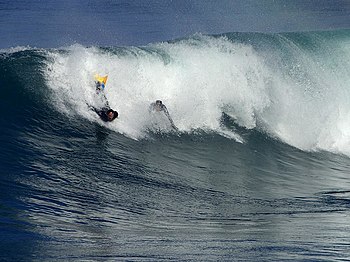Bodysurfing: Difference between revisions
| Line 35: | Line 35: | ||
|-http://www.surffestival.org |
|-http://www.surffestival.org |
||
| Bodysurfing Clubs and Breaks |
| Bodysurfing Clubs and Breaks |
||
| [http://www.santacruzbodysurfing.org/ Santa Cruz], [http://www.bodysurfing.com.br/ Assoc. Carioca de Surf de Peito (Brazil)], [http://www.boomerbits.com/ Boomer], [http://gillisbeach.org/ Gillis Beach Bodysurfing |
| [http://www.santacruzbodysurfing.org/ Santa Cruz], [http://www.bodysurfing.com.br/ Assoc. Carioca de Surf de Peito (Brazil)], [http://www.boomerbits.com/ Boomer], [http://gillisbeach.org/ Gillis Beach Bodysurfing Association], [http://www.surfingfrance.com/federation/disciplines/bodysurf Fédération Française de Surf], [http://www.bodysurfing.com.au/ Bodysurfing Australia], [http://www.facebook.com/pages/Manta-Bodysurf-Club/56781574225 Manta Bodysurf Club (Mexico)] |
||
|- |
|- |
||
| Bodysurfing Videos |
| Bodysurfing Videos |
||
Revision as of 16:06, 31 October 2009

Bodysurfing is the art and sport of riding a wave without the assistance of any buoyant device such as a surfboard or bodyboard. Bodysurfers typically equip themselves only with a pair of specialized swimfins that stay on during turbulent conditions and optimize propulsion. Some practitioners also carry or wear a small planing surface on the hand to aid with positioning on the wave face. These include Hand Paddles, Hand Guns, Wave Blades, Redwings and others used to gain extra speed across the face of the wave.
Technique
To get on the wave, bodysurfers must pick a direction, swim or paddle hard, use their back or an outstretched arm, and ride the wave in a streamline position. Left and right turns can be performed by digging the shoulder into the wave, causing the person to slide to the side of the wave. To exit the wave immediately after catching it, simply drop the head and a tumble turn will exit the person out of the wave. Care must be taken to ensure the water is deep enough so that no injury is brought about by the head, neck, and shoulders hitting the sand. Other tricks or variations include underwater takeoffs, like the "Dolphin Pop" which involves diving towards the shore in waist-deep water as the wave prepares to break, resulting in popping out on the wave like a dolphin, as well as spins, barrel rolls, and the ever-popular getting pounded.
Some bodysurfers have a minimalist attitude toward wave riding and consider their sport to be more pure than other forms of riding waves. Because velocity is slower without a board (due to increased drag and limited planing ability), bodysurfers tend to focus on barrel riding. Consequently, bodysurfers tend to congregate on slower waves or shorebreak, where close-out barrels are the flavor of the day. Getting "tubed" is generally considered the grail of surfing, which may help explain the superior attitude bodysurfers have toward their sport. Some surfers in Hawaii have stated that they use bodysurfing as conditioning for big wave riding.
The Wedge
One of the most famous bodysurfing spots in the world is The Wedge, located in Newport Beach, California. Wave faces there can reach upwards of 30ft and more on big southern hemisphere and hurricane-generated swells during the spring, summer, and fall. Known mainly for high performance bodysurfing and intense jaw dropping rides and wipeouts, these waves are created by swells hitting the jetty and "rebounding" into oncoming waves, creating the "wedge effect," which results in peaks that can "jack up" to incredible sizes and shapes. When it is "on," The Wedge is for experienced riders only. The Wedge is to bodysurfing what the Pipeline is to surfing: the best bodysurfers prove themselves at The Wedge, as do the best stand-up surfers at Pipeline.
Contests
Annually, the Pipeline Bodysurfing Classic competition runs at the world famous Banzai Pipeline. This event is considered to be a world class pro/am competition, and yet is also considered one of the truly unique underground surf contests around. Among the bodysurfing population at large, the event is considered the premiere event internationally. It's one of the only times bodysurfers have access to the cream of the Pipeline's waves.
The World Bodysurfing Championships along with the Pipeline Bodysurfing Classic are the two biggest bodysurfing competitions in the World according to the Encyclopedia of Surfing. It started in 1977, runs every August in Oceanside, CA. Another long time contest is the Manhattan Beach Bodysurfing Contest in Manhattan Beach, CA sponsored by the oldest Bodysurfing Club in The United States, Gillis Beach Bodysurfing Association. Dating back to 1964 the Gillis Beach Bodysurfing Association or GBBA, formed on the beaches of Playa Del Rey in Los Angles. Members of GBBA run Bodysurfing Contest, but do not participate in the interest of promoting the sport. The contest is a part of the International Surf Festival held late July or the first of August annually. The surf festival is known for its volleyball, Lifeguard competition and the Bodysurfing Contests.
Also in Mexico, between April and June in Ixtapa-Zihuatanejo, at Las Escolleras beach takes place the tournament called Torneo Internacional de Bodysurf Las Escolleras, where the competitors challenge the powerful pipes in this famous waves of world-class, with the notoriety that this two days event is not charged subscription to the competition, but it rewards the first 4 places of the category, with trophies and gifts from sponsors and make a big party with live music at the beach as the pure style of Sharing The Aloha Spirit.
In addition to the contests above there are numerous other contests in California and Hawaii. Many clubs and contests can be found in France, Brazil, Australia. Both France and Brazil have a series of contests to determine a national champion.
References
- "Secrets of a Kahuna Bodysurfer:A Spiritual Adventure Guide" by Lani E Lowel (1999/2006)
- The Art of Bodysurfing by Robert Gardner (1972)
- Bodysurf by Hugo Verlomme and Laurent Masurel (2002)
- The Art of Wave Riding by Ron Drummond (1931)
- The Encyclopedia of Surfing", 2005, Matt Warshaw, Harcourt Books, ISBN 0-15-100579-6
